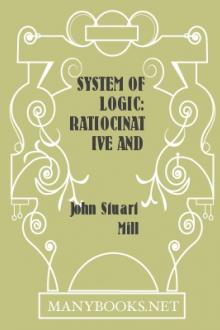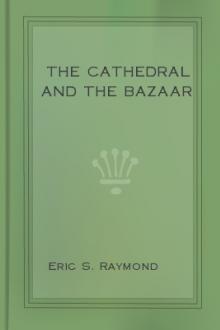A System of Logic: Ratiocinative and Inductive, John Stuart Mill [best books to read now .txt] 📗

- Author: John Stuart Mill
- Performer: -
Book online «A System of Logic: Ratiocinative and Inductive, John Stuart Mill [best books to read now .txt] 📗». Author John Stuart Mill
There are nevertheless, in mathematics, some examples of so-called Induction, in which the conclusion does bear the appearance of a generalization grounded on some of the particular cases included in it. A mathematician, when he has calculated a sufficient number of the terms of an algebraical or arithmetical series to have ascertained what is called the law of the series, does not hesitate to fill up any number of the succeeding terms without repeating the calculations. But I apprehend he only does so when it is apparent from à priori considerations (which might be exhibited in the form of demonstration) that the mode of formation of the subsequent terms, each from that which preceded it, must be similar to the formation of the terms which have been already calculated. And when the attempt has been hazarded without the sanction of such general considerations, there are instances on record in which it has led to false results.
It is said that Newton discovered the binomial theorem by induction; by raising a binomial successively to a certain number of powers, and comparing those powers with one another until he detected the relation in which the algebraic formula of each power stands to the exponent of that power, and to the two terms of the binomial. The fact is not improbable: but a mathematician like Newton, who seemed to arrive per saltum at principles and conclusions that ordinary mathematicians only reached by a succession of steps, certainly could not have performed the comparison in question without being led by it to the à priori ground of the law; since any one who understands sufficiently the nature of multiplication to venture upon multiplying several lines of symbols at one operation, cannot but perceive that in raising a binomial to a power, the coefficients must depend on the laws of permutation and combination: and as soon as this is recognised, the theorem is demonstrated. Indeed, when once it was seen that the law prevailed in a few of the lower powers, its identity with the law of permutation would at once suggest the considerations which prove it to obtain universally. Even, therefore, such cases as these, are but examples of what I have called Induction by parity of reasoning, that is, not really Induction, because not involving inference of a general proposition from particular instances.
§ 3. There remains a third improper use of the term Induction, which it is of real importance to clear up, because the theory of Induction has been, in no ordinary degree, confused by it, and because the confusion is exemplified in the most recent and elaborate treatise on the inductive philosophy which exists in our language. The error in question is that of confounding a mere description, by general terms, of a set of observed phenomena, with an induction from them.
Suppose that a phenomenon consists of parts, and that these parts are only capable of being observed separately, and as it were piecemeal. When the observations have been made, there is a convenience (amounting for many purposes to a necessity) in obtaining a representation of the phenomenon as a whole, by combining, or as we may say, piecing these detached fragments together. A navigator sailing in the midst of the ocean discovers land: he cannot at first, or by any one observation, determine whether it is a continent or an island; but he coasts along it, and after a few days finds himself to have sailed completely round it: he then pronounces it an island. Now there was no particular time or place of observation at which he could perceive that this land was entirely surrounded by water: he ascertained the fact by a succession of partial observations, and then selected a general expression which summed up in two or three words the whole of what he so observed. But is there anything of the nature of an induction in this process? Did he infer anything that had not been observed, from something else which had? Certainly not. He had observed the whole of what the proposition asserts. That the land in question is an island, is not an inference from the partial facts which the navigator saw in the course of his circumnavigation; it is the facts themselves; it is a summary of those facts; the description of a complex fact, to which those simpler ones are as the parts of a whole.
Now there is, I conceive, no difference in kind between this simple operation, and that by which Kepler ascertained the nature of the planetary orbits: and Kepler's operation, all at least that was characteristic in it, was not more an inductive act than that of our supposed navigator.
The object of Kepler was to determine the real path described by each of the planets, or let us say by the planet Mars (since it was of that body that he first established the two of his three laws which did not require a comparison of planets). To do this there was no other mode than that of direct observation: and all which observation could do was to ascertain a great number of the successive places of the planet; or rather, of its apparent places. That the planet occupied successively all these positions, or at all events, positions which produced the same impressions on the eye, and that it passed from one of these to another insensibly, and without any apparent breach of continuity; thus much the senses, with the aid of the proper instruments, could ascertain. What Kepler did more than this, was to find what sort of a curve these different points would make, supposing them to be all joined together. He expressed the whole series of the observed places of Mars by what Dr. Whewell calls the general conception of an ellipse. This operation was far from being as easy as that of the navigator who expressed the series of his observations on successive points of the coast by the general conception of an island. But it is the very same sort of operation; and if the one is not an induction but a description, this must also be true of the other.
The only real induction concerned in the case, consisted in inferring that because the observed places of Mars were correctly represented by points in an imaginary ellipse, therefore Mars would continue to revolve in that same ellipse; and in concluding (before the gap had been filled up by further observations) that the positions of the planet during the time which intervened between two observations, must have coincided with the intermediate points of the curve. For these were facts which had not been directly observed. They were inferences from the observations; facts inferred, as distinguished from facts seen. But these inferences were so far from being a part of Kepler's philosophical operation, that they had been drawn long before he was born. Astronomers had long known that the planets periodically returned to the same places. When this had been ascertained, there was no induction left for Kepler to make, nor did he make any further induction. He merely applied his new conception to the facts inferred, as he did to the facts observed. Knowing already that the planets continued to move in the same paths; when he found that an ellipse correctly represented the past path, he knew that it would represent the future path. In finding a compendious expression for the one set of facts, he found one for the other: but he found the expression only, not the inference; nor did he (which is the true test of a general truth) add anything to the power of prediction already possessed.
§ 4. The descriptive operation which enables a number of details to be summed up in a single proposition, Dr. Whewell, by an aptly chosen expression, has termed the Colligation of Facts. In most of his observations concerning that mental process I fully agree, and would gladly transfer all that portion of his book into my own pages. I only think him mistaken in setting up this kind of operation, which according to the old and received meaning of the term, is not induction at all, as the type of induction generally; and laying down, throughout his work, as principles of induction, the principles of mere colligation.
Dr. Whewell maintains that the general proposition which binds together the particular facts, and makes them, as it were, one fact, is not the mere sum of those facts, but something more, since there is introduced a conception of the mind, which did not exist in the facts themselves. "The particular facts," says he,[3] "are not merely brought together, but there is a new element added to the combination by the very act of thought by which they are combined.... When the Greeks, after long observing the motions of the planets, saw that these motions might be rightly considered as produced by the motion of one wheel revolving in the inside of another wheel, these wheels were creations of their minds, added to the facts which they perceived by sense. And even if the wheels were no longer supposed to be material, but were reduced to mere geometrical spheres or circles, they were not the less products of the mind alone,—something additional to the facts observed. The same is the case in all other discoveries. The facts are known, but they are insulated and unconnected, till the discoverer supplies from his own store a principle of connexion. The pearls are there, but they will not hang together till some one provides the string."
Let me first remark that Dr. Whewell, in this passage, blends together, indiscriminately, examples of both the processes which I am endeavouring to distinguish from one another. When the Greeks abandoned the supposition that the planetary motions were produced by the revolution of material wheels, and fell back upon the idea of "mere geometrical spheres or circles," there was more in this change of opinion than the mere substitution of an ideal curve for a physical one. There was the abandonment of a theory, and the replacement of it by a mere description. No one would think of calling the doctrine of material wheels a mere description. That doctrine was an attempt to point out the force by which the planets were acted upon, and compelled to move in their orbits. But when, by a great step in philosophy, the materiality of the wheels was discarded, and the geometrical forms alone retained, the attempt to account for the motions was given up, and what was left of the theory was a mere description of the orbits. The assertion that the planets were





Comments (0)